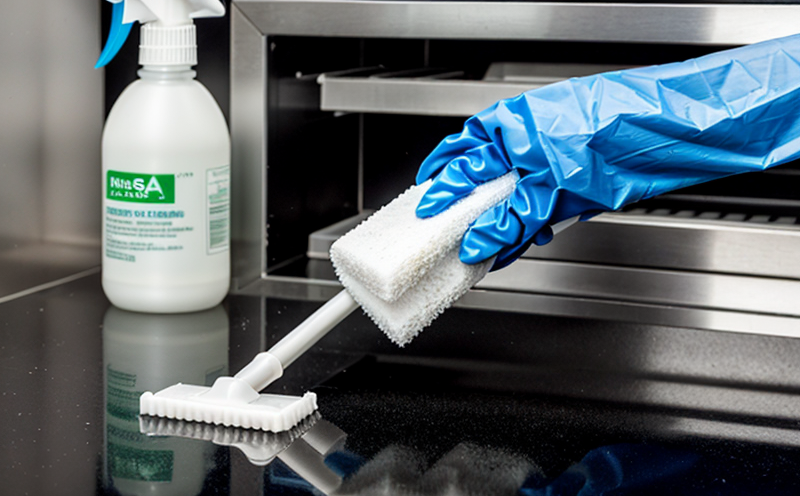ASTM E3135 Antimicrobial Surface Activity Testing of Plastics
The ASTM E3135 standard method is a critical tool in evaluating the antimicrobial surface activity of plastics. This test determines whether plastic materials are capable of inhibiting or killing microorganisms on their surfaces, which is essential for products used in cleaning and hygiene applications.
This testing ensures that plastic items like medical devices, food packaging, and consumer goods meet stringent hygiene standards. The ASTM E3135 protocol involves exposing a defined surface area of the test material to a standardized inoculum of microorganisms under controlled conditions. The effectiveness is then assessed based on microbial population reduction.
The test parameters are carefully specified in the standard, including the type and concentration of antimicrobial agent used, the incubation time, and the method of microbial recovery and counting. Specimen preparation involves precise cutting to ensure reproducibility across multiple samples.
Instrumentation typically includes an incubator for maintaining controlled temperature conditions during the test period, a microscope or spectrophotometer for quantifying microbial populations, and a balance for accurate weighing of specimens and reagents.
| Test Parameter | Description |
|---|---|
| Type of Antimicrobial Agent | Solutions or materials containing antimicrobial compounds. |
| Inoculum Type and Concentration | Bacterial cultures at specified concentrations. |
| Incubation Time | 24 hours at 37°C for bacteria. |
| Microbial Population Reduction | Percentage decrease in microbial count post-treatment. |
The ASTM E3135 method is widely used across industries to ensure that products meet hygiene and safety standards. Compliance with this standard can be a key differentiator for manufacturers seeking to gain market share in the healthcare, food processing, and consumer goods sectors.
- Ensures compliance with international hygiene standards.
- Enhances product reputation by meeting regulatory requirements.
- Supports R&D efforts in developing more effective antimicrobial plastics.
The importance of this testing cannot be overstated. In an era where public health and safety are paramount, the ability to verify that a plastic material can inhibit or kill microorganisms on its surface is crucial for maintaining trust with consumers and stakeholders.
Why It Matters
The ASTM E3135 method plays a pivotal role in ensuring that plastics used in cleaning and hygiene applications are effective against microbial contaminants. This testing is particularly important given the increasing prevalence of antibiotic-resistant bacteria and other pathogens.
In healthcare settings, for instance, antimicrobial surfaces can significantly reduce the risk of hospital-acquired infections. In food packaging, the ability to prevent bacterial growth on plastic surfaces helps maintain product integrity and safety. Even in consumer goods like toothbrushes or kitchen utensils, ensuring that their materials are capable of inhibiting microbial growth is essential.
The results of this test provide critical information for quality managers and compliance officers responsible for ensuring that products meet hygiene standards. For R&D engineers, the test offers valuable insights into material properties and potential improvements in antimicrobial efficacy. In procurement, it ensures that suppliers deliver materials meeting these high standards.
Benefits
- Enhanced Product Safety: Ensures products are safe for use by the public or patients.
- Improved Hygiene Standards: Meets international hygiene and safety standards.
- Increased Consumer Trust: Builds confidence in product quality and effectiveness.
- Regulatory Compliance: Helps avoid penalties associated with non-compliance.
- R&D Insights: Provides data to guide further development of antimicrobial plastics.
The ASTM E3135 method offers numerous benefits, making it an indispensable tool for manufacturers and researchers. By ensuring that products meet the highest hygiene standards, this testing contributes significantly to public health and safety.
Industry Applications
| Application Sector | Description of Application |
|---|---|
| Healthcare | Evaluating antimicrobial properties for medical devices and implants. |
| Food Processing | Determining effectiveness in preventing bacterial growth on packaging materials. |
| Consumer Goods | Ensuring hygiene standards for items like toothbrushes, kitchen utensils, etc. |
The ASTM E3135 method finds application across various sectors. In healthcare, it is crucial for evaluating the antimicrobial properties of medical devices and implants. For food processing, the test ensures that packaging materials prevent bacterial growth effectively. In consumer goods, it guarantees hygiene standards in everyday items like toothbrushes and kitchen utensils.
- Healthcare: Medical device manufacturers can assess the efficacy of their products against pathogens.
- Food Processing: Packaging companies can verify that their materials inhibit bacterial growth effectively.
- Consumer Goods: Manufacturers can ensure that their products maintain hygiene standards, enhancing consumer trust.
The widespread use of this testing in these sectors underscores its importance in maintaining public health and safety.





